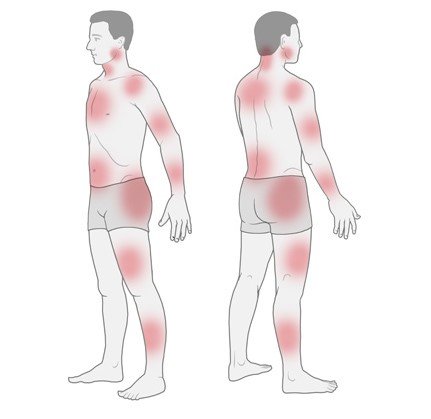Aaron LA, Buchwald D. A review of the evidence for overlap among unexplained clinical conditions. Ann Intern Med 2001; 134(9 Pt 2): 868-881.
Adams EH, McElroy HJ, Udall M et al. Progression of fibromyalgia: results from a 2-year observational fibromyalgia and chronic pain study in the US. J Pain Res 2016; 9: 325-336.
Arnold LM, Crofford LJ, Mease PJ et al. Patient perspectives on the impact of fibromyalgia. Patient Educ Couns 2008; 73(1): 114-120.
Bidonde J, Busch AJ, Schachter CL et al. Mixed exercise training for adults with fibromyalgia. Cochrane Database Syst Rev 2019; (5): CD013340.
Clauw DJ. Fibromyalgia: a clinical review. JAMA 2014; 311(15): 1547-1555.
Dennis NL, Larkin M, Derbyshire SW. "A giant mess" - making sense of complexity in the accounts of people with fibromyalgia. Br J Health Psychol 2013; 18(4): 763-781.
Derry S, Cording M, Wiffen PJ et al. Pregabalin for pain in fibromyalgia in adults. Cochrane Database Syst Rev 2016; (9): CD011790.
Deutsche Schmerzgesellschaft. Definition, Pathophysiologie, Diagnostik und Therapie des Fibromyalgiesyndroms (S3-Leitlinie, Kurzfassung). AWMF-Registernr.: 145-004 (under revision). 2022.
Fitzcharles MA, Ste-Marie PA, Goldenberg DL et al. 2012 Canadian Guidelines for the diagnosis and management of fibromyalgia syndrome: executive summary. Pain Res Manag 2013; 18(3): 119-126.
Lunn MP, Hughes RA, Wiffen PJ. Duloxetine for treating painful neuropathy, chronic pain or fibromyalgia. Cochrane Database Syst Rev 2014; (1): CD007115.
Martinez-Calderon J, Flores-Cortes M, Morales-Asencio JM et al. Intervention Therapies to Reduce Pain-Related Fear in Fibromyalgia Syndrome: A Systematic Review of Randomized Clinical Trials. Pain Med 2021; 22(2): 481-498.
Moore RA, Derry S, Aldington D et al. Amitriptyline for fibromyalgia in adults. Cochrane Database Syst Rev 2015; (7): CD011824.
Skelly AC, Chou R, Dettori JR et al. Noninvasive Nonpharmacological Treatment for Chronic Pain: A Systematic Review Update. (AHRQ Comparative Effectiveness Reviews; No. 227). 2020.
Walitt B, Fitzcharles MA, Hassett AL et al. The longitudinal outcome of fibromyalgia: a study of 1555 patients. J Rheumatol 2011; 38(10): 2238-2246.
Wolfe F, Brähler E, Hinz A et al. Fibromyalgia prevalence, somatic symptom reporting, and the dimensionality of polysymptomatic distress: results from a survey of the general population. Arthritis Care Res (Hoboken) 2013; 65(5): 777-785.
IQWiG health information is written with the aim of helping people understand the advantages and disadvantages of the main treatment options and health care services.
Because IQWiG is a German institute, some of the information provided here is specific to the German health care system. The suitability of any of the described options in an individual case can be determined by talking to a doctor. informedhealth.org can provide support for talks with doctors and other medical professionals, but cannot replace them. We do not offer individual consultations.
Our information is based on the results of good-quality studies. It is written by a team of health care professionals, scientists and editors, and reviewed by external experts. You can find a detailed description of how our health information is produced and updated in our methods.


